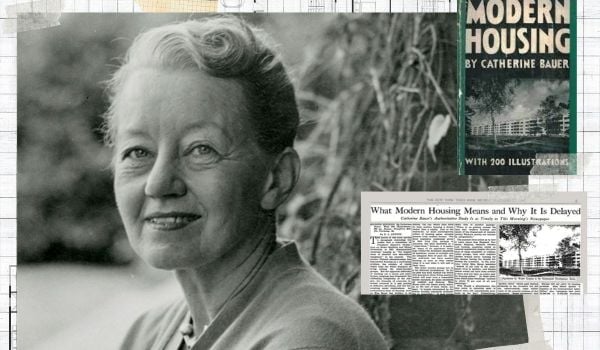Parents and caretakers pushing around — and valet parking — high-priced baby strollers. The average rent for just a one-bedroom apartment is $2,644, up from $1,503 in 2009. These are some of the reasons Brooklyn’s Park Slope neighborhood has earned a reputation for affluence. But that’s not stopping the Fifth Avenue Committee (FAC) from fighting to preserve and even grow Park Slope’s supply of affordable housing.
In that effort, the nonprofit community development corporation is using a financing approach that has largely flown under the radar: tapping into retirement assets. At a time when the National Low Income Housing Coalition calculates that there’s only 35 affordable units available for every 100 of the country’s poorest renters, and government subsidies for affordable housing are shrinking while building costs are increasing, turning to America’s retirement piggy bank could be an important part of the solution.
Add up what’s been put aside in the private and public sectors, and you get a $27 trillion pot of money that’s being invested on behalf of future retirees. Getting access to that pot of money requires navigating through a forest of rules and gatekeepers, but the few in community development and affordable housing finance who have reached the other side have found a warm welcome.
Earlier this year, two nonprofit community development lenders issued a cumulative $150 million in corporate bonds — with much of that investment coming from pension funds and mutual funds holding billions in retirement assets. Another nonprofit community development lender, Capital Impact Partners, has so far raised $50 million through an investment offering targeted at big Wall Street money managers as well as individuals managing some of their own retirement savings.
“There’s a tremendous opportunity for people to connect their investments to their values,” says Ellis Carr, president and CEO of Capital Impact Partners. “As we think about the work we do across the country, we thought that could be a huge opportunity for people to come in to help bring capital to areas that don’t have it.”
A City Pension That’s Healthy for All
As NYC and New York state pension funds get headlines for remaining invested in payday lenders or, on the flip side, for divesting from fossil fuels or from private prisons, it begs the question: where else could those dollars go? FAC’s experience in NYC provides more than just a hint of what’s possible.
FAC has been building and managing affordable housing in and around Park Slope since 1978. In a project not unlike many previous projects, it’s currently renovating 13 buildings with a total of 84 units of affordable housing and some ground-floor retail — just a portion of the total 600 units of affordable housing that the nonprofit has built or acquired, with an additional 400 in its development pipeline.
The 13 buildings under renovation will get new insulation and new windows, energy efficient lighting, low-flow toilets and other water-saving fixtures. Before renovation, the rents in the 13 buildings were running between $700 and $800 a month. After renovations are complete in spring 2018, all the existing tenants who want to come back can return, and the rents will not go up a single penny. In fact, the rent won’t go up for at least the next 50 years. That’s made possible by the buildings’ energy and water efficiency savings for FAC — and low-interest, long-term financing from NYC’s public pension funds.
Retirement assets, including public pension funds, have longterm horizons. Under normal circumstances, cities, states, companies or people may not need to touch retirement savings for 20 or 30 years or more — making them ideal funds to for making long-term loans to affordable housing developers like FAC. But getting access to those funds for affordable housing has not been easy, and remains fraught with barriers.
In 1983, NYC became one of the first few city and state governments that decided to dedicate a portion of its public pension funds to make investments back into the neighborhoods where their contributors (taxpayers) came from and where many of their beneficiaries lived. These programs became known as “economically-targeted investment” or ETI programs. Under NYC’s ETI program, the city vigorously vetted and then granted authority to a nonprofit, mission-driven lender, the Community Preservation Corporation (CPC), to make long-term, fixed-rate loans to affordable housing developers using pension fund dollars.
ETI programs have gone in and out of favor with federal regulators at the Department of Labor, which oversees the enforcement of retirement plan rules, under the authority of ERISA, the Employee Retirement and Income Security Act. The purpose of the ERISA guidelines is to protect the future income of retirees—so that retirement asset managers don’t make investments that are too risky. Of course, it’s not a perfect set of rules—billions, if not trillions in retirement assets evaporated as a result of the 2009 financial crisis. (Technically, public pension funds aren’t required to follow ERISA rules, but they hew closely to them as a “gold standard.”)
Depending on who is in the White House, regulators may feel it’s too risky to include non-financial factors — such as wanting to make a positive impact in a neighborhood grappling with disinvestment — in making investment decisions. In 2015, ETI programs came back into favor after a cooling-off period that started at the end of President George W. Bush’s administration.
“These new [ERISA] guidelines help spell out our fiduciary duty, and they make it easier for us to explain how our investments help everyday New Yorkers,” says NYC Comptroller Scott M. Stringer, via email. “They reaffirmed that our investment strategy was on the right path — and that our ETI program produces strong returns while decreasing risk and helping working families afford to live in our City.”
Over time, CPC has become a fixture of NYC’s ETI program, providing a stable, predictable source of long-term capital for the city’s community-based nonprofit developers, like FAC. As a nonprofit and a community development financial institution, CPC is able to do things that banks aren’t willing or able to do, like lend to nonprofit developers or small for-profit developers who don’t have much cash to put up for collateral.
“These longstanding relationships have stood the test of time, changes in political leadership, and different real estate cycles,” says Rafael Cestero, CPC president and CEO.
In New York State, it is also necessary to obtain mortgage insurance available from the State of New York Mortgage Agency, or SONYMA. For a fee, the mortgage insurance provides an additional guarantee to public pension funds that they will be paid back. Every affordable housing loan out of the NYC or NY state pension funds has to be insured by SONYMA. It adds a bit more paperwork and time to closing a deal, says Jay Marcus, director of housing development at FAC, but at this point community-based developers like FAC are used to it.
“It’s become easier because it’s more standardized, everyone is familiar with it, and you know in advance what you need to do earlier on,” says Marcus.
So far, using NYC public pension fund dollars, CPC has provided permanent financing for 710 projects totaling $898 million dollars in NYC, encompassing 30,442 affordable housing units. Using New York state public pension fund dollars, CPC has provided financing that’s led to the creation or preservation of 19,499 affordable housing units outside New York City.
Today there are multiple fund managers under NYC’s ETI program. One is the national $6 billion AFL-CIO Housing Investment Trust (HIT), which focuses on maximizing the number of jobs per investment dollar. The projects in which it invests must utilize 100 percent union labor. Nationwide, about a quarter of HIT’s 390 investors are various state and local public pension funds, with the rest coming mostly from collectively owned union pension funds. Since joining NYC’s ETI program in 2002, HIT has made 52 different investments in NYC, totaling about $1.2 billion, representing a total of 34,500 affordable housing units. Nationwide, HIT has financed over 107,000 units of housing, generating more than 78,900 union jobs.
“Some of that is new construction, some is financing to provide major rehab, sometimes there’s also opportunities to invest to preserve the affordability of those properties,” says Lesyllee White, executive vice president and managing director of defined benefit marketing at HIT. “Because of the huge demand in affordable housing, or because of the huge need for improving our national infrastructure, or more demand for investing locally, I would say that there has been a surge of folks trying to identify who is actually making those investments.”
Another manager in NYC’s ETI program, RBC Global Asset Management, focuses largely on affordable homeownership, with a specific mandate to ensure the loans made to low- and moderate-income homeowners are not predatory. Since 2007, RBC Global Asset Management has used pension fund dollars to provide financing for more than $397 million in home mortgages to 1,887 single-family homeowners in NYC — an average of $210,386 per home, far below the NYC average of $575,700 sales price of a coop, condo or a family home with one to three units in 2014.
The NYC Comptroller’s office currently has the authority to place up to two percent of its assets into ETI programs — around $3.6 billion out of $191 billion in total assets. It’s a number established under the oversight of the trustees of the five NYC public pension funds, a total of around 60 people, including elected officials like the mayor as well as other public officials and also labor representatives. A spattering of financial advisors and consultancies typically work closely with the trustees to make informed decisions.
“There’s been some periods of time where it has been easier [to access pension fund dollars] than others,” says Ronald Homer, who manages NYC public pension fund dollars as head of the Access Capital Fund at RBC. “I think we’re in a period now where there are more people asking the question ‘can we do this?’”
Tapping the Private Sector
Across the U.S., state and local public pension funds hold $3.7 trillion in investments, while private pension funds hold another $3 trillion or so. ETI programs are found throughout all of them. Earlier this year, Pacific Community Ventures (PCV) published a study and catalogue of all ETI programs in public and private pension funds across the U.S. Since the 1960s, the study estimates, public and private pension funds have made $86 billion in over 100 ETIs.
While many ETI programs focused on making in-state investments in underserved areas with pension dollars, PCV’s study only confirmed three active ETI programs that had a specific investment strategy for affordable housing. Getting more private or public retirement assets into affordable housing may take more than a few willing cities or states.
“I think one of the interesting developments is some of the big CDFIs getting S&P rated, so they have been hearing more from pension funds,” says Tom Woelfel, PCV’s head of global research and co-author of their ETI study. “It creates new opportunities for pension funds. The credit rating can make CDFIs something that are really attractive to them.”
Retirement asset managers, who manage most pension funds and most of the rest of the $27 trillion in America’s retirement piggy bank, typically won’t touch any investment without seeing at least a rating from one of the three major rating agencies (S&P, or Standard and Poor’s, Moody’s and Fitch). They’ll even make a small percentage of investments with a high risk, expecting a high return, as long as the investment has a rating.
It’s an expensive, intense process, but so far five community development financial institutions, all very active in affordable housing, have gone out and gotten an S&P rating: LISC, Reinvestment Fund, Capital Impact Partners, Housing Trust Silicon Valley, and Clearinghouse CDFI. All five S&P-rated CDFIs so far have an AA or AA- rating, indicating a relatively low-risk investment. The big three rating agencies, including Moody’s or Fitch as well as S&P, typically re-evaluate ratings on an annual basis.
In leveraging its AA rating to raise $50 million in capital since October 2017, Capital Impact Partners has seen investments come in from large asset management firms, as well as from individual investors via platforms like E-Trade, Scottrade, TD Ameritrade and Charles Schwab. The minimum investment size was $1,000, and a few investments came in at that amount. Their target is to raise $100 million, opening up to investors about one business week out of every month until they do.
In addition to the impact from having more flexible, longer-term capital available for affordable housing and other community development needs, Carr also sees broader potential impact from having a broader investor base: policy change.
Even with more private capital coming into community development and affordable housing, public subsidies are still necessary to ensure that capital can subsidize truly affordable housing or broader community development needs. CPC, Capital Impact Partners, LISC, Reinvestment Fund and other community development lenders all still rely on public programs to prime the pump of affordable housing projects. At the federal level, there’s the U.S. Treasury’s CDFI Fund, New Markets Tax Credits, Low-Income Housing Tax Credits, Historic Preservation Tax Credits, Community Development Block Grants and other programs. At the state and local level, programs or agencies like the State of New York Mortgage Agency are essential. Community development lenders have become experts at leveraging public dollars and public support alongside private dollars, including retirement dollars. According to the CDFI Fund, community development lenders leverage $12 of private capital for every $1 of public investment.
As more future retirees find that their savings are invested in affordable housing, community development lenders see them as potential political allies to preserve and maybe even grow the community development ecosystem. Until now, the biggest source of capital for community development lenders have been foundations or banks, who either don’t want to get too much into politics or have their own policy priorities. Most of the retirement asset managers, public and private pension funds, insurance companies, and even individuals who are taking advantage of new opportunities like Capital Impact Partners’ monthly investment offerings are all newer investors to community development and affordable housing.
“It really helps to build a partnership and relationship with these investors,” Carr says. “There’s a need to broaden and diversify sources of capital for our industry, and from a policy perspective, if CDFIs could be a name brand that people could recognize it could help maintain a favorable policy environment.”
This article is part of The Bottom Line, a series exploring scalable solutions for problems related to affordability, inclusive economic growth and access to capital. Click here to subscribe to our Bottom Line newsletter.

Oscar is Next City's senior economic justice correspondent. He previously served as Next City’s editor from 2018-2019, and was a Next City Equitable Cities Fellow from 2015-2016. Since 2011, Oscar has covered community development finance, community banking, impact investing, economic development, housing and more for media outlets such as Shelterforce, B Magazine, Impact Alpha and Fast Company.
Follow Oscar .(JavaScript must be enabled to view this email address)


















